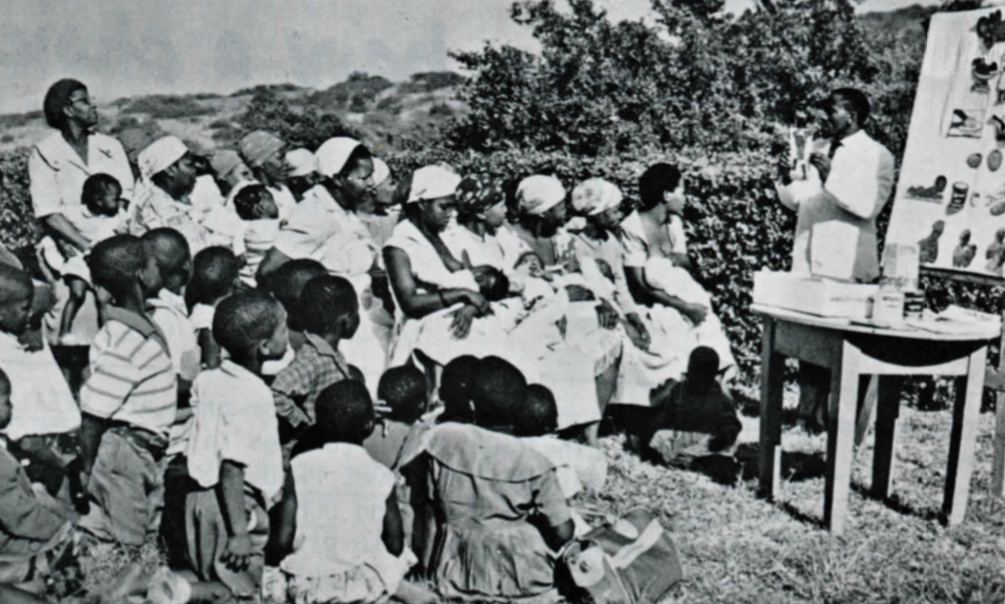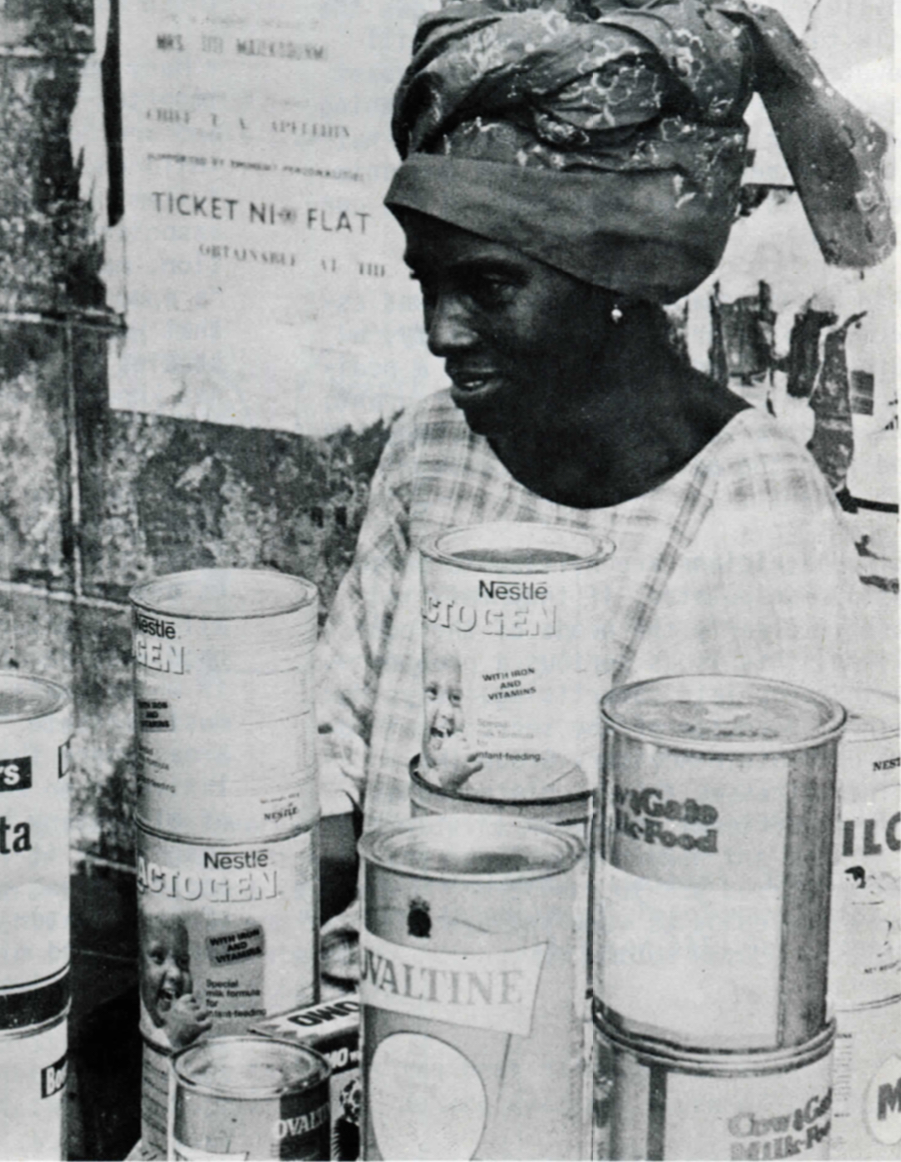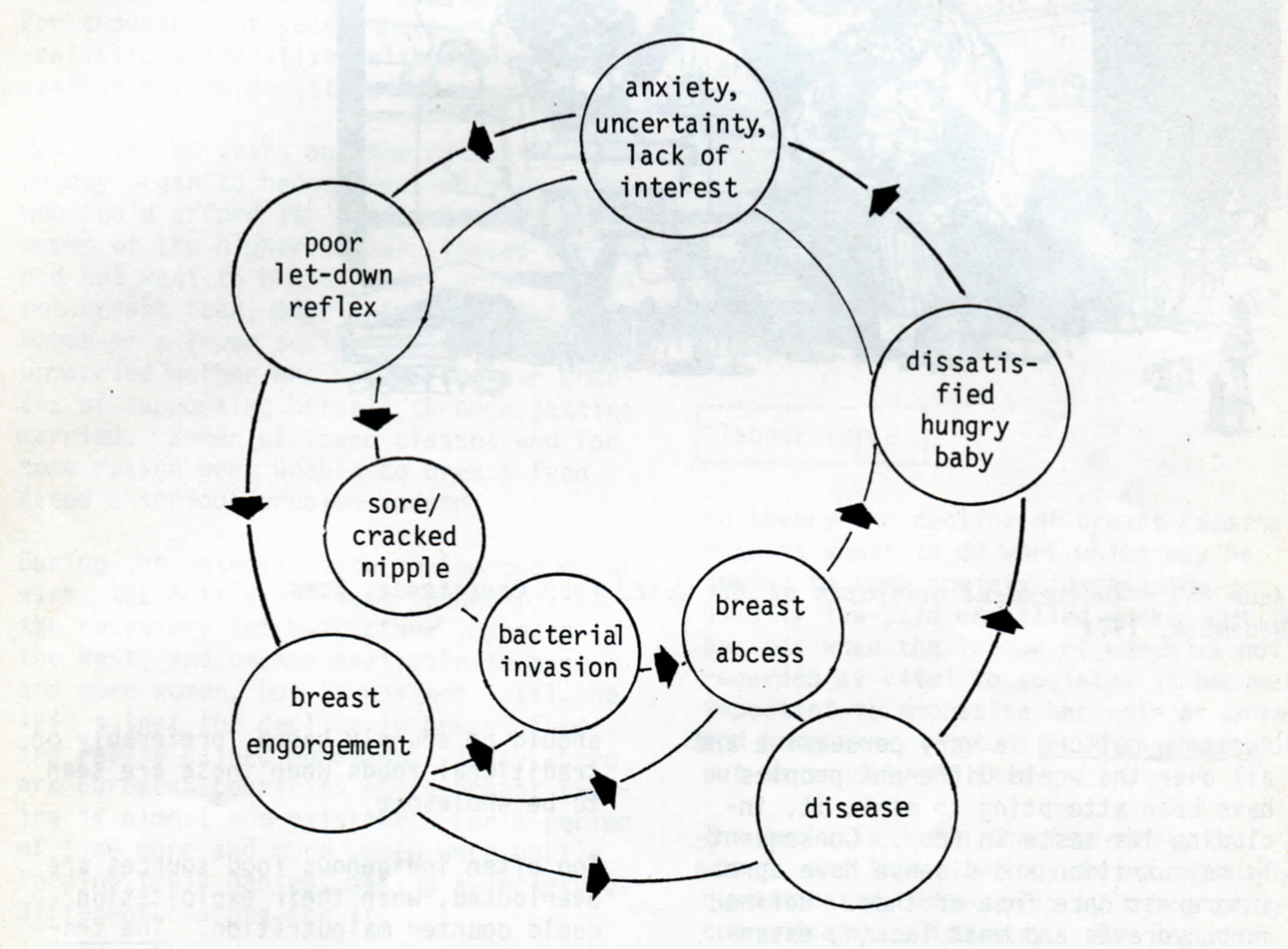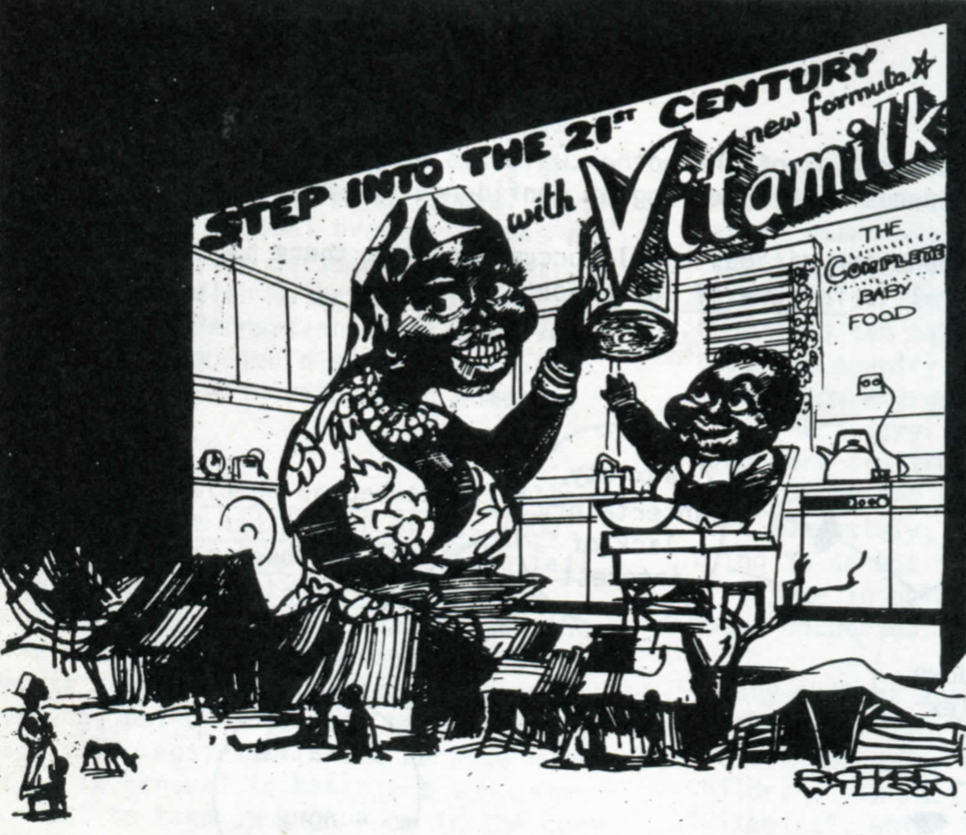Who and how?
What does it look like?
Do women have a choice?
The companies concerned are numerous, but the major ones are NESTLE (Switzerland), COW & GATE (United Kingdom), GLAXO (United Kingdom), ABBOTT (also called Ross Laboratories, USA), AMERICAN HOME PRODUCTS (Wyeth Laboratories, USA), BRISTOL-MYERS (Mead Johnson, USA), and DUMEX (Det Ost-Asiatiske Kompagni, Denmark). It is not possible here to give details of all these companies, but readers who are interested in pursuing this should consult the Resources section of this guide for details of groups/liberature dealing with the companies.
"...There are 81 Nestle product factories in 27 developing countries where we employ over 27,000 people out of a total of 116,000, and many more are planned. It should not be overlooked that these factories make a lasting contribution since, once they have been built, they cannot be shifted or destroyed. Thus, they will always work for the benefit of the country's economy."
P. Liotard -Vogt, Nestlé President, 1975

marketing:unethical methods
What follows is part of the statement by Dr. D.B. Jelliffe, School of Public Health, Los Angeles, November 1974. It was submitted to the Bern Court as testimony for the Defence in the Nestlé libel case, heard on 26 February 1976 (see section 3, Switzerland, for details).
Causes for this change in pattern of infant feeding are multiple, complex and "occidentogenic" (derived from Western cultural influences). They include principally the effects of health services and health staff (who have not been trained to appreciate the dangers of bottle feeding in such circumstances), various factors in the changed life-style adopted by new townsmen (including the usually small percentage of mothers who have to go to work outside the home) and the unethical promotion of the sale of formulas by commercial concerns.
The adjective "unethical" is used in this context as such advertisements include the use of techniques of persuasion and motivation based on prestige, upward social mobility, etc. in communities where (a) there is no possibility of such formulas being purchasable in adequate quantities or used in a cleanly fashion, and/or (b) in communities where breast feeding is still the norm.
All major infant food firms, especially the large international concerns, have continually carried out such advertising and promotional campaigns in competition with each other in less developed countries since World War II.
Without any doubt whatsoever, they have been one of the major factors responsible for the present decline in breast feeding in areas where bottle feeding is neither economically nor hygienically feasible.
They have therefore also been responsible in considerable measure for the present rise in the prevalence of marasmus and diarrheal disease in such regions with its high mortality, costly and prolonged treatment, and considerable risk of permanent brain damage.
"Advertising by commercial milk firms was on an even vaster scale than at first anticipated. 14% of the mothers said they were encouraged to bottle feed by a commercial milk nurse. However, many more had been visited at home and given samples of proprietary milk. The hospital itself was used as a centre for easy access to postpartum mothers, and the commercial milk nurses waited outside the postnatal clinics with free milk samples.
The influence of advertising is probably much greater than the 14% indicated. In view of the increased incidence of gastroenteritis associated with bottle feeding, this must be a cause for concern."
S. Grantham-McGregor, "Breast Feeding in Kingston Jamaica", Arch. Dis. Chldhd. 1970, 45, 404.
The methods employed in such promotional campaigns have included the widest use of mass media, such as the newspapers, radio, and in some circumstances television. The hold of such advertisers on the mass media of developing countries is because they are often the main (or only) source of revenue.
Posters/Charts
In addition, milk companies, have flooded the health services with advertising and promotional material, directly and indirectly. Direct advertising may be via posters, pamphlets and free samples "to assist in the running of the clinic". These are particularly difficult to resist as to health personnel inexperienced in such matters these seem only to be offers of much needed help in circumstances where there is a shortage of teaching material and of supplementary foods.
"Can you imagine a healthy, well fed mother leaving a government delivery ward with a tin of free NAN tinned milk for her two-day old baby? This is the best way of discouraging breast feeding and spreading the bottle and the manufacturers know where to grab us."
Dr. T.N. Maletnlema, "Breast Feeding is the Best for Your Baby", in Sunday News, Tanzania, 8.12.74. Nan is a Nestle product.
All too often the walls of health centers and hospitals can be covered with posters donated by infant food companies. The paradox of the hard-pressed public health nurse teaching one thing and posters more forcefully declaiming another is very frequently not appreciated by health staff.
In addition, milk companies, as with the pharmaceutical industry, have become adept at what is to them low-cost molding of professional opinion by "manipulation by assistance" and by "endorsement by association".
Milk Nurses
One of the most insidious forms of advertising and promotion is that carried out by so-called "milk nurses". These are trained nurses who are attracted understandably by better conditions of service from government work to commerce. They are employed by milk companies in theory to assist governmental health services with infant care and hygiene, including home visiting. In fact, one of their major functions is to promote directly and indirectly the products of the particular company, in competition with other groups of milk nurses employed by other companies. They usually are able to gain entry to hospitals, even if this is forbidden by regulations, and to give free samples to mothers and to nursing staff. In addition,they obtain the names and addresses of mothers who have given birth and visit them at home with advice, information and free samples. They are, in fact, a network of promoters of the particular product.
"I happened to see them by chance - there was never an official introduction and when they became aware of my critical attitude, they avoided me and dealt with the health sister only. Not surprisingly, I saw more and more feeding bottles, for instance in the small village Igangan, where I saw on a certain day 10 out of 36 mothers waiting for the clinic, carrying a feeding bottle in their bag, the inside of the teats black encrusted."
Catherine A.M. WENNEN-van der Mey M.D., from her statement to the Bern Court, 1974.
The Need?
The point of view often expressed by such milk firms is that, in fact, they fill a felt need. According to this perspective mothers in urban regions will inevitably fail to breast feed and their products will, therefore, be available to fill the vacuum. In fact, the percentage of mothers in such developing countries who are going out to work away from home and who may, therefore, require some form of artificial bottle feeds varies considerably, but is often rather small. In any case, the argument of milk companies in this regard is without substance, as the need under these circumstances would be for a low-cost, minimally advertised form of breast milk surrogate and not for the extremely costly and highly advertised formulas promoted by infant food companies.
In discussion with senior officials from infant food companies it is often contended that in fact their company was not involved in such unethical, high-pressure promotional tactics or, alternatively, that such practices as the use of commercial milk nurses was on the decline. Such does not seem to be the case. In particular, in Kingston, Jamaica, very considerable attention has been given this subject in recent years, and milk companies are well aware of the concern that informed pediatric and nutritional professionals have in this regard. A recent study undertaken by the Tropical Metabolism Research Unit at the University of the West Indies in early 1973 showed that nearly one-fifth of mothers giving birth at the University Hospital of the West Indies were visited shortly after the delivery by commercial milk nurses, who were not officially permitted to enter ward, and were given samples of their milks.
Nestlé processes 7,500,000 tons of milk per year, and reckons to be the world's largest buyer of both coffee and cocoa.

And the Medical Profession?
"Although many individual doctors recommend breast feeding, the medical profession as a whole has stood on the sidelines throughout this minor social revolution. 'The medical profession was not supportive of the decision to breast feed', says Helen Guthrie, Professor of Nutrition at Pennsylvania State University, who conducted a survey in 1965 to find out what was influencing women to breast feed.
A major US textbook on pediatrics allocates only one and a half of its 1600 pages to breast feeding, and these fail even to mention let-down reflex, the physiological mechanism that allows the milk to flow. Medical schools still devote very little attention to breast feeding, not because they have anything particular against it, but because nutrition in general is a subject too unimportant to take up much room in the curriculum.
When a department of pediatrics was established at an African university, a large baby food company offered a pediatrics prize and $1,000 research grant. 'Here for a very little outlay they had modified the action of the pediatrics department'.
'If pediatricians are willing to be so easily manipulated, if they fail to observe clearly the needs of the poor client, this is as serious a problem as inappropriate advertising,' says Max Milner, director of the secretariat for the UN Protein-Advisory Group (Mr. Milner stresses this is his personal and not official view).
from "Bottle Feeding: Adverse effects of Western Technology", by Nicholas Wade, in Science, vol. 184 No. 4132.
"Food aid carried out by international organisations or charitable institutions can be extremely useful in specific cases, but it can also be a "poisoned gift", in so far as it leads the population into the habit of consuming food that the country itself cannot produce. Apart from emergency situations where it is necessary to give food, it is much more fruitful to help the population to use the available resources more adequately; it is a more difficult thing to do but in the long run much more effective in helping the development of these countries.
- Many mothers are convinced that only imported foreign fruits contain vitamins and are "good for the health" of their children. In fact the very idea of "vitamins", which is foreign to them, is associated with imported fruit. In addition, many doctors and nurses prescribe "a spoonful of orange juice" because that was what they learnt during their studies in Europe, and they simply do not know the vitamin C content of the local fruits.
- In the same way, skillful advertising has succeeded in persuading many women "that tinned milk bought at the chemists' is better than mother's milk". First of all it is expensive, thus it must be good, and secondly it is sold by people in white coats in the chemists', which must indicate "health value". In areas where the majority of women have little or no education, have no knowledge of elementary hygiene (and even if they learnt it, it is extremely difficult to apply because of living conditions, lack of fresh water etc.), the use of bottles and powdered milk causes thousands of cases of serious gastroenteritis."
from "Evolution de l'Alimentation dans les pays en voie de développement, de T. Brun et H. Dupin, dans Cahiers Nut. Diét., VIII, 4, mars 1975.
The Let-Down Reflex
This is the psycho-somatic reflex of the mother which is responsible for the actual ejection of milk. It depends on her feeling of confidence and ability to breast feed.
The following diagram shows the vicious circle occurring when there is a lack of confidence. The sum total is failure of lactation."

"Too often the result will be that the over-worked midwife makes the immediate diagnosis of 'not enough milk' or 'milk does not suit the baby', and either the baby is removed or at best a temporary bottle feed is given. The effect of the bottle is to further diminish the mother's confidence and to encourage the baby to accept more easily the milk which is so often over-sweetened." (Dr. David Morley in Paediatric Priorities in the Developing World, 1973)
"The phrase 'if or when your breast milk fails' is the best sabotage to the let-down reflex I know." (Professor Derrick Jelliffe, during evidence given at the Bern Court case, February 1976)

"Western culture is very persuasive and all over the world different peoples have been attempting to mimic it, including its taste in food. Consequently malnutrition and disease have spread into areas once free of them. Refined carbohydrates and meat lacking essential fats but riddled with adipose fat, are the biggest scourge. The incidences of diabetes, peptic ulcer, intestinal diverticulitis, dental caries, renal stones, and heart disease have all soared over the past 50 years except where people still live on their traditional diets.
Nutritionists have a very important role not only in identifying malnutrition so that help can be forthcoming, but also in ensuring that the diet of the people should be soundly based, preferably on traditional foods when these are seen to be wholesome.
Too often indigenous food sources are overlooked, when their exploitation could counter malnutrition. The tragedy is that people on the brink of malnutrition tend to abandon their traditional foods for commercial food. They give up breast feeding, use polished rice instead of home-pounded rice, and refined flour and sugar instead of using whole grains."
from "Malnutrition - Don't Force-Feed New Diets", by Peter Bunyard in PAN - newspaper of the World Food Conference, Rome November 1975.

